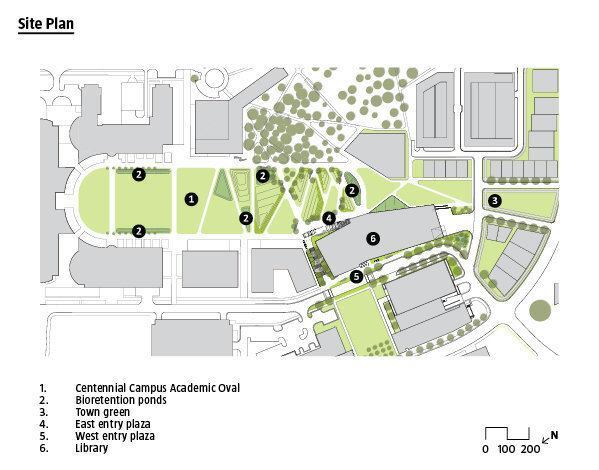
With the exception of parking structures—and one or two brutalist buildings from the 1960s and ’70s—the North Carolina State University (NC State) campus in Raleigh is dominated by brick buildings in neo-Georgian style. But the latest addition to campus—Snøhetta’s glazed and louver-clad James B. Hunt Jr. Library—brings something different to the landscape, both in color and in content.

The five-story bent rectangle of the Hunt Library peeks above the red masonry structures of NC State, providing students with a gathering place on the southern side of campus while also doubling the university library’s capacity. Although colors permeate the library’s interiors, its façades—fritted glass on the north and south elevations, and glass-and-aluminum along the east and west—trend toward monochrome, with the glazing offering hints of blue-gray at certain times of day. This makes the 220,000-square-foot Hunt Library stand out around the Centennial Campus Academic Oval. “It seems like an arc of the imagination floating through this sea of brick,” says Snøhetta founding principal Craig Dykers, AIA. The building’s angled form also funnels axial views from the academic green toward nearby Lake Raleigh.

Along the building’s north façade, stepped berms disguise the 16-foot grade change between the Oval and adjacent facilities downhill. Entering the library from the lower level, visitors immediately encounter Robot Alley, where they can watch the BookBot—as the school has affectionately named its 2-million-volume automated storage and retrieval system—in action. An adjacent, vivid yellow stair leads up to the library’s main lobby on the second level.


The library shares the double-height lobby with a think-tank called the Institute for Emerging Issues. The space gives way to a triple-height reading lounge with an east-facing panoramic view over a rain-collecting rock garden and the Oval. A quiet reading room beyond is lined with glazed group study rooms that overlook the double-height space from the third floor. Visitors have their choice of color-coded vertical circulation paths to move between levels: Vibrant yellow stairways trace through the library, while elevator banks are a more subdued aubergine.


In this digital-first era, a new library can raise eyebrows for those who think that print media—and the buildings that house them—are antiquated, but the Hunt Library is not a place for dust to settle on books. Instead, it aims to be a lively hub where students can interact with new technologies. “We knew very early on that this was more a research and collaborative space than a traditional library,” says Snøhetta project manager Nicholas Rader. “The university wanted something that showed NC State was forward-thinking in keeping up with the pace of technology and providing an opportunity not only to the students, but to the whole state.”

To that end, adaptable spaces for creative work are central to the new facility. Budget cutbacks forced Snøhetta (working with local architect Pearce Brinkley Cease + Lee, which has since merged with Clark Nexsen), to eliminate a planned sixth floor. So the design team pushed the BookBot below grade, which opened the remaining upper floors to be used for a visualization lab and a creativity studio for projected digital environments, which share a small workshop boasting two 3D printers, a 3D scanner, and a laser cutter. “It’s a technology sandbox for the campus,” says Maurice York, the head of IT for NC State’s libraries. “We’re at a point where a library isn’t just about text anymore. We wanted to put technology into the students’ hands and see what they could do.”


The university had requested an iconic building from Snøhetta to showcase all of these technologies. But, Dykers asks, “What does iconic mean? It used to mean something sculptural,” he says. “From our perspective, society is past that stage of understanding.” He calls the Hunt Library “more of a social monument, so that what you do in it becomes more of a memory than the building itself.”



Project Credits
Project James B. Hunt Jr. Library, Raleigh, N.C.
Client North Carolina State University
Architect Snøhetta, New York—Craig Dykers, AIA (partner in charge); Elaine Molinar, AIA, Nic Rader, Fred Holt, Jon Kontuly, Misako Murata, Maura Rockcastle
Executive Architect Clark Nexsen (formerly Pearce Brinkley Cease + Lee), Raleigh, N.C.—Clymer Cease, AIA (partner in charge); Donna Francis, AIA, Doug Brinkley, FAIA, Shann Rushing, AIA, Ryan Johnson, Katelyn Ottaway
M/E/P/F Engineer Affiliated Engineers
Structural Engineer Stewart Engineering
Civil Engineer Cole Jenest Stone
Construction Manager Skanska
Landscape Architect Snøhetta
Executive Landscape Architect Susan Hatchell Landscape Architecture
Lighting Designer Pivotal
Programming DEGW
Cost Consultant Davis Langdon
LEED Administration Clark Nexsen (formerly Pearce Brinkley Cease + Lee)
Structural Consultant Arup
Audiovisual/IT/Acoustics Sextant Group
Furniture NCSU Libraries, Clark Nexsen (formerly Pearce Brinkley Cease +Lee) with Another Inside Job
Library Collection Capacity More than 2 million volumes
Size 264,000 square feet (24,526 square meters)
Cost $73 million
Material and Sources
Automated Book Delivery System Dematic dematic.com
Concrete Blair Concrete donleysconcrete.com
Curtainwall, Glass, and Metal Panels Trainor Glass
Electrical T&H Electric thelectrical.net
Mechanical John J. Kirlin jjkllc.com
Miscellaneous Steel Smith Architectural Metals smithmetals.net
Quiet Reading Room Furnishings Thos. Moser mosercontract.com
Structural Steel CMC South Carolina Steel cmc.com
















